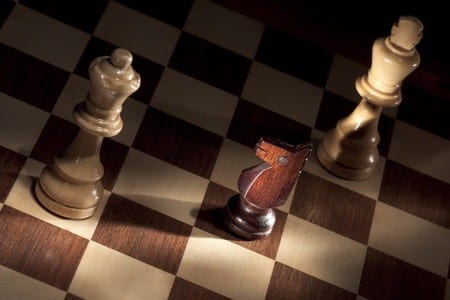My entire Chess Blog has been leading up to this riveting conclusion: I don’t like Chess and I don’t want to learn more about chess. It sounds counterintuitive; tell people I love chess and teach them to play, just when they’re excited to learn for themselves explain everything you hate about chess. And yet as if the title wasn’t confusing enough, take a look at this Rubik’s Cube of chess pieces! There is a reason, I promise.
(Image made by Michael Magnotti)
Before I start with my comparison, it might help to know where the cube came from. I don’t mean to sound pretentious or braggy, but I taught myself to solve a Rubik’s cube. Anyone that can read algorithms (pattern of moves) can solve the cube, which is why I don’t think it’s impressive to be able to solve it. The people that hold records for the fastest solving time accomplish it by creating their own algorithms. For example, one of the algorithms I know uses 9 moves to complete; however, a new algorithm was found that uses 11 moves but it is faster because of how easily a human hand can move the cube.
I often compare Chess to a Rubik’s Cube in order to explain this metaphor. As mentioned in previous posts, there are some famous games that are studied, and famous moves that are repeated. Similar to the algorithms of a Rubik’s Cube, Chess has openings and mating nets (an algorithm of which pieces to move and where). Here are some examples:
(Figure 1: Queens Gambit Opening)
 (Figure 2: Anastasia’s Mating Net)
(Figure 2: Anastasia’s Mating Net)
As you can see, there are specific patterns that one can use given the opportunity. You don’t need to worry about having spacial awareness (similar to a Rubik’s Cube), you only need to be able to recognize the positions and apply the correct pattern.
I wasn’t aware of this until I had a conversation with some people from a local chess club. One of the members beat me every time, destroyed me. I couldn’t figure out how to fight him better yet try to win! I asked a friend of his why he was beating me and his friend told me “he uses the London System. It’s hard to beat unless you use a [insert superior algorithm here]”. He didn’t tell me what I was doing wrong, he told me I was using the wrong patterns.
Maybe this fact rips away the romantic view of Chess that I want to maintain, maybe I don’t like thinking I can lose because I don’t know the algorithm. Either way, I don’t want to think of Chess as a game of memorization, I want to think of it as a game of wit. To bring back the metaphor, do you remember how the fastest solvers got to that level? They came up with new algorithms to help them. The greatest players in the game got there, not because they remembered the patterns, but because they found a way to beat the ones they were faced with.
Of course, these new moves became patterns, but it happened because the player was smart enough to find a weakness and attack it. That’s what I want Chess to be, and why I don’t like how chess is taught now. In my opinion, Chess shouldn’t be a game anyone can win if they know how to read an opening or mating net. Chess should be a game anyone can win if they take the time to learn the board and hone their spatial awareness to recognize the better move, not the better pattern.
____________________________________________
Remember to Say It With Your Chess!
– Michael Magnotti
Part-time writer, Michael Magnotti, thrives on leading passionate people to see the world in different ways. Although Michael writes about very different topics, he uses them all as an easy-to-read guide for seeing what you didn’t know was there!
____________________________________________
Resources:



 Fortunately, some pieces like the pawns can move many spaces forward at a time, making it easier to get to reach the center before your opponent. After control of the center has been taken, pieces can start to capture or take the opponent’s pieces. If you remember anything from this blog, remember this: The number one rule when developing your pieces is to never move a piece twice. If you continue to develop multiple pieces, you can gain better control than if you move one piece again and again. The more pieces you have to work with the better off you will be! Chess is not won by trading material but by forcing the opponent to make choices. Luckily, many different strategies exist to aid us in our fight.
Fortunately, some pieces like the pawns can move many spaces forward at a time, making it easier to get to reach the center before your opponent. After control of the center has been taken, pieces can start to capture or take the opponent’s pieces. If you remember anything from this blog, remember this: The number one rule when developing your pieces is to never move a piece twice. If you continue to develop multiple pieces, you can gain better control than if you move one piece again and again. The more pieces you have to work with the better off you will be! Chess is not won by trading material but by forcing the opponent to make choices. Luckily, many different strategies exist to aid us in our fight.







